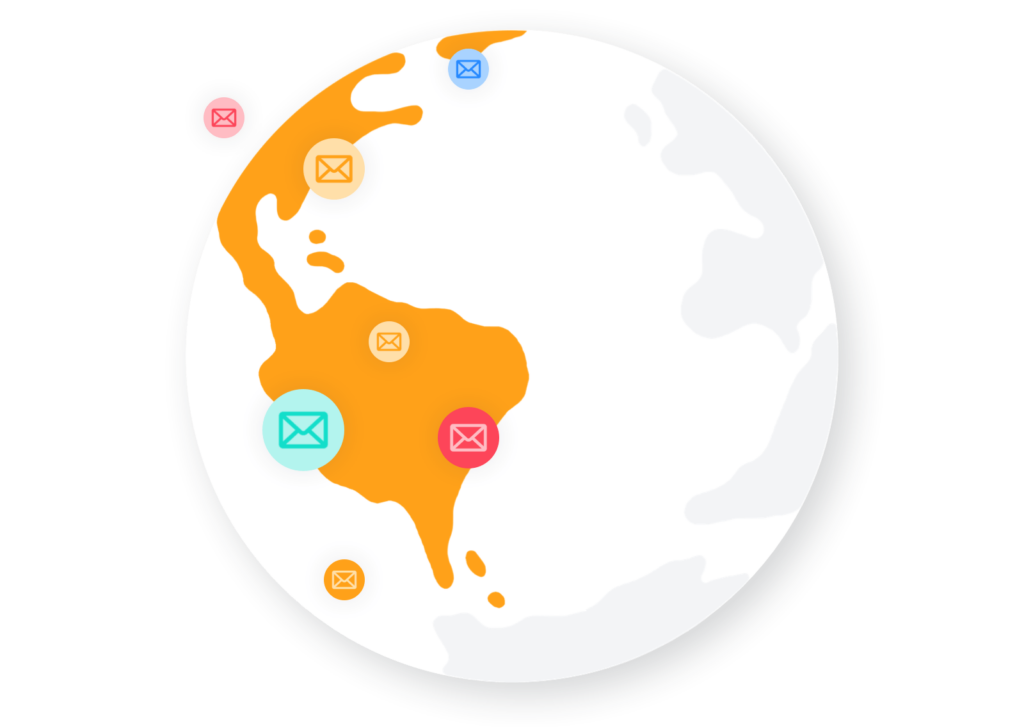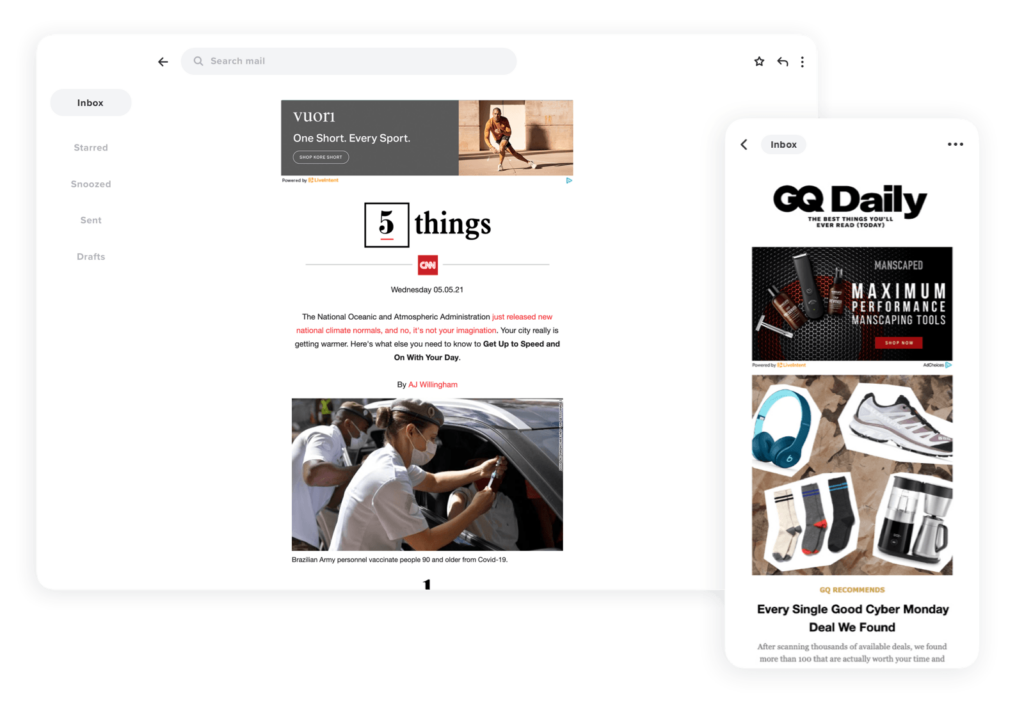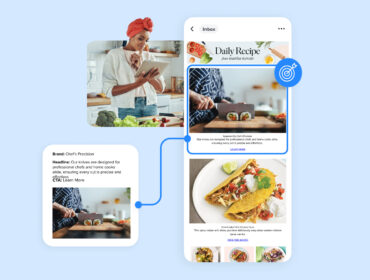Email newsletter monetization: Everything you need to know
With more than 4.2 billion email users, email newsletter monetization is the perfect complement to any existing revenue strategy.
Yes, you read that correctly, email newsletters.

However, successfully monetizing your email newsletters means doing a little more than just slapping some content together and hitting send. There’s a lot to consider; from growing your newsletter audience to branding and design, each piece is a part of the larger monetization puzzle. With a thoughtful approach, the payoffs can be massive. For instance, media company Morning Brew drove 95 percent of its revenue from newsletter monetization alone in 2019.
Now, there’s no one-size-fits-all approach, but the proper foundation puts your newsletters on the path to success.
Email newsletter monetization refers to selling premium newsletter ad inventory that advertisers can purchase, directly or programmatically.

What makes it premium, you ask? Email newsletters provide access to highly engaged, logged-in audiences. The logged-in nature of email newsletters allows advertisers to deliver highly targeted, people-based ads, no matter the device.
Furthermore, email is an inherently cookieless environment. As brands and publishers adapt to a world without third-party cookies, email newsletters will become even more critical to reaching and engaging audiences. But we’ll get into that later.
By selling email newsletter ad inventory, you help advertisers reach your newsletter subscribers with relevant ads while securing incremental revenue. With 49% of consumers saying they’d like to receive weekly promotional emails, email monetization is a win-win-win opportunity for publishers, brands, and subscribers alike.

Apart from driving revenue, there are other reasons for monetizing email newsletters. Let’s take a look.
Diversify revenue:
If the last few years have taught businesses anything, it’s that you can’t put all your eggs in one basket. By monetizing your email newsletters, you can transform a content distribution channel into a net-new revenue stream. Through this revenue diversification tactic, you alleviate reliance on a single source of revenue and mitigate risk.
Expand your first-party data footprint:
Email newsletters are one of the best ways to help you expand your first-party data footprint, a critical component to business success in a world after third-party cookies. You need robust insights that enable you and your advertiser partners to take quick, strategic action.

Email newsletters require readers to opt-in or subscribe by providing their email addresses. This creates a value exchange between the newsletter sender and the subscriber: content in exchange for first-party data. Furthermore, email newsletters enable publishers to collect other crucial behavioral information, like what ads readers clicked on, articles they read, or which of your webpages they via your newsletter. With this first-party data, you can better monetize your audiences and deliver relevant, personalized advertising experiences for your subscribers.
Consumer privacy:
Email hashing (a way of encrypting email addresses) allows you to create a privacy-safe way for you and advertiser partners to use first-party data. With email newsletters and email hashing, you can provide your advertiser partners the trust and confidence they need to safely and securely reach their audiences while upholding consumer privacy.
Now, email newsletter monetization isn’t just for large, traditional publishers. Small to medium-sized businesses in any industry can use email monetization. Additionally, brands across verticals can also leverage email monetization to secure revenue and drive business growth.

That’s not all you can do with email ad inventory, though! You can also use email ad slots to promote your private labels, brand products, or services. You can even advertise your products in other email newsletters. However, if you’re only interested in advertising your brand in other email newsletters — and not selling ad inventory — you’ll want to check out this blog post.
Email monetization is a good option if you’re a publisher that has:
An existing newsletter. The content already exists, so why not monetize it? Adding ad slots to your newsletter is a great way to generate net-new revenue and an opportunity to put valuable, relevant offers in front of your subscribers.
An ad sales team. Many publishers overlook adding their newsletters to their media kits. Don’t make this mistake! There are undoubtedly advertising partners who will be excited about getting their messages in front of your engaged audience.
Limited resources. Suppose you’re trying to create monetization opportunities but have limited staffing and resources. In that case, programmatic exchanges and networks are a great way to generate revenue opportunities without adding much time to your team’s task list.

Does any of the above apply to your company? If so, email monetization may be a fitting addition to your revenue strategy.
The considerations above are also true for brands thinking about email newsletter monetization. Here are some others:
You have affiliate partners. Email is perfect for extending your reach beyond your website and for promoting your own or affiliate products.
You want to understand your customers better. Engagement with email advertisements can help you collect shopper data from email audiences and boost your internal analytics and CDP by resolving email and web shopper data.
You’re in growth mode. Email newsletter monetization is a powerful tool for growing your email subscriber list, increasing subscription revenue, and building loyalty programs.

Want to see how brands put email newsletter monetization to work? Check out how Groupon and General Mills do it. With the right partner, you can accelerate your brand’s growth without taxing your hardworking team.
Email newsletters are valuable to both your revenue and marketing departments. And although these teams are two sides of the same coin — your business — and have similar goals, they often struggle to see eye-to-eye. This usually comes down to disagreements on whether investments should be revenue or marketing-focused. With the right approach to email newsletter monetization, however, email newsletters can help them achieve both revenue and marketing goals like:
- Earning newsletter revenue
- Increasing newsletter subscriptions
- Selling products or services
- Building strong customer relationships
By placing and selling ad inventory in your email newsletters, your revenue team can secure a steady revenue stream by leveraging existing assets and customer relationships. Furthermore, with solutions like native ads, it’s easy to monetize email without a design overhaul. Learn more about our native ad solution, Native Ad Blueprints, on our dedicated solution page.

Similarly, marketing departments can continue to nurture customer relationships through email ads. Marketing teams can use their ad slots to promote their most relevant products or offers to their newsletter readers when newsletter advertising demand is low.
So while revenue teams boast incremental revenue, the marketing team can delight in new subscribers or customers, and both teams secure data that speaks to audience engagement and interest. Together with these insights and a growing first-party data footprint, these teams can unlock tremendous growth for their organization.
Now that you know why email newsletter monetization is essential to most modern businesses let’s look at how you can drive demand for your email ad inventory.
There are a few different options to consider depending on your business goals.

Direct-sold: A direct-sold campaign is when an advertiser and publisher have directly contracted an agreement. A direct deal is a good fit for publishers with a large team who can manage additional inventory and trafficking.
Open exchange: If you want to reach a wider network of advertisers, this option allows you to choose which demand side platform can access your inventory. Several advertisers can compete for your inventory via the open exchange.
Deals and packages: Finally, you can maximize niche audiences and inventory by offering seasonal, audience, or content-based deals and packages. Entice advertisers willing to pay a premium for highly convertible and unique audiences.
Determining the right demand source for your business is not a one-size-fits-all approach. You and your team of stakeholders must decide what’s most important to the company and its goals. From there, don’t be afraid to shift and learn as you go.

Now, before you embark on your email newsletter monetization journey, check out these best practices to ensure a strong start.
Create high-quality content
Don’t send an email just for the sake of it. Make sure each message has high-quality, valuable content. A good rule of thumb? Treat every newsletter you send like all future open rates depend on the content of that individual email – because, to a large extent, they do!
Plan for personalization
In the world of email, personalization is king. Your users don’t want to feel like another number in an endless email list. For example, a personalized subject line generates a 50% higher open rate.

Sell units above the fold
Content that sits above the fold does not require the users to scroll to see it. Because this is one of the first things seen once a subscriber opens a message, these ad slots are worth the most.
Enable various ad sizes
Enable all ad sizes for each slot to make the most of the space in each email. This tactic ensures more advertisers can bid for the inventory.

Boost email capture
You’ll need to evolve your email acquisition tactics regularly and campaigns to grow and strengthen your email list.
Constantly improve analytics
Analytics help you determine the best time to send and which emails are the most successful. Now is the time to invest in any first-party data you can get.
Email newsletters are a powerful – and lucrative – tool. Follow these best practices, and you’ll be well on your way to ensuring success for your brand with newsletter monetization.
Email is one of the most underrated revenue channels for brands and publishers. If you have a highly engaged email list and dedicate resources toward creating personalized, actionable content, you might miss out on an opportunity for monetization.
Are you ready to take the next step to transform your newsletter into a powerful and profitable media channel? Check out our Publisher Solutions page.



